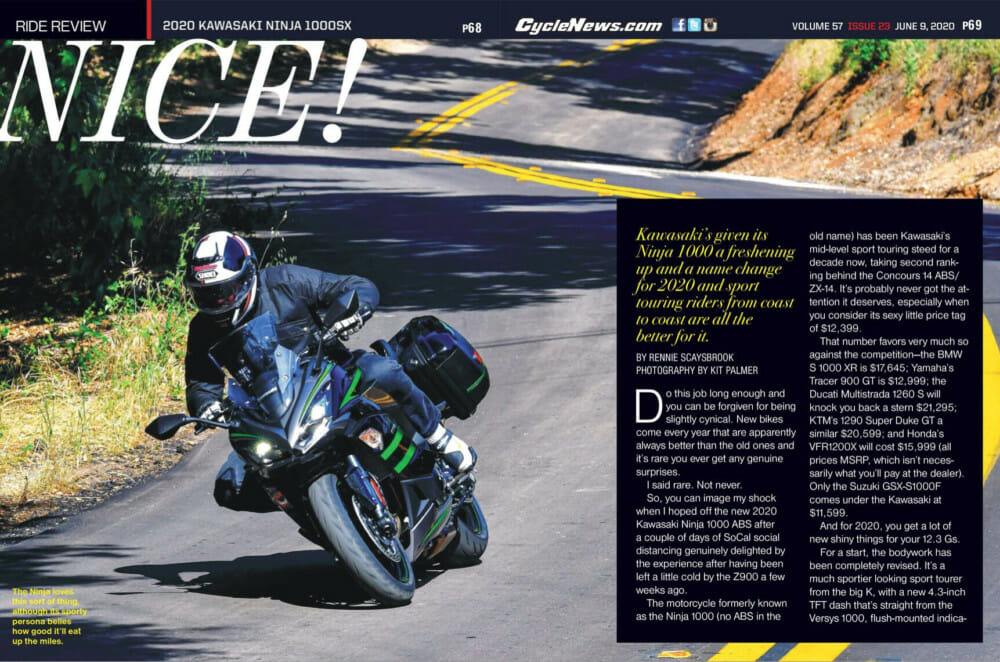Rennie Scaysbrook | June 23, 2020
Kawasaki’s given its Ninja 1000 a freshening up and a name change for 2020 and sport-touring riders from coast to coast are all the better for it.
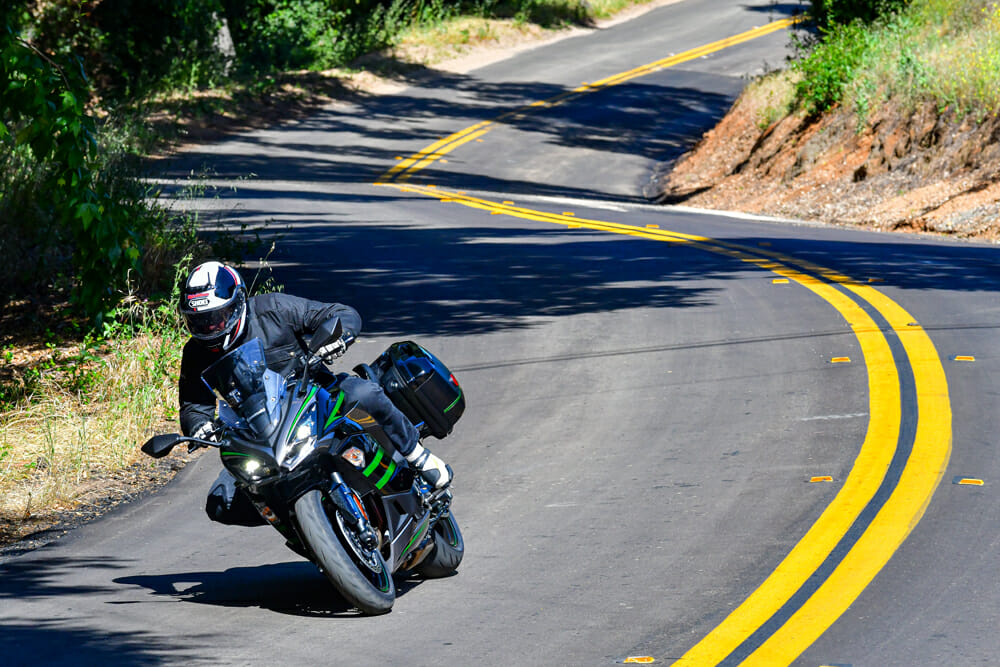 The Ninja loves this sort of thing, although its sporty persona belies how good it’ll eat up the miles.
The Ninja loves this sort of thing, although its sporty persona belies how good it’ll eat up the miles.
Photography by Kit Palmer
Do this job long enough and you can be forgiven for being slightly cynical. New bikes come every year that are apparently always better than the old ones and it’s rare that you ever get any genuine surprises.
I said rare. Not never.
So, you can image my shock when I hopped off the new 2020 Kawasaki Ninja 1000 ABS after a couple of days of So Cal social distancing genuinely delighted by the experience after having been left a little cold by the Z900 a few weeks ago.
The motorcycle formerly known as the Ninja 1000 (no ABS in the old name) has been Kawasaki’s mid-level sport touring steed for a decade now, taking second ranking behind the Concours 14 ABS/ZX-14. It’s probably never got the attention it deserves, especially when you consider its sexy little price tag of $12,399.
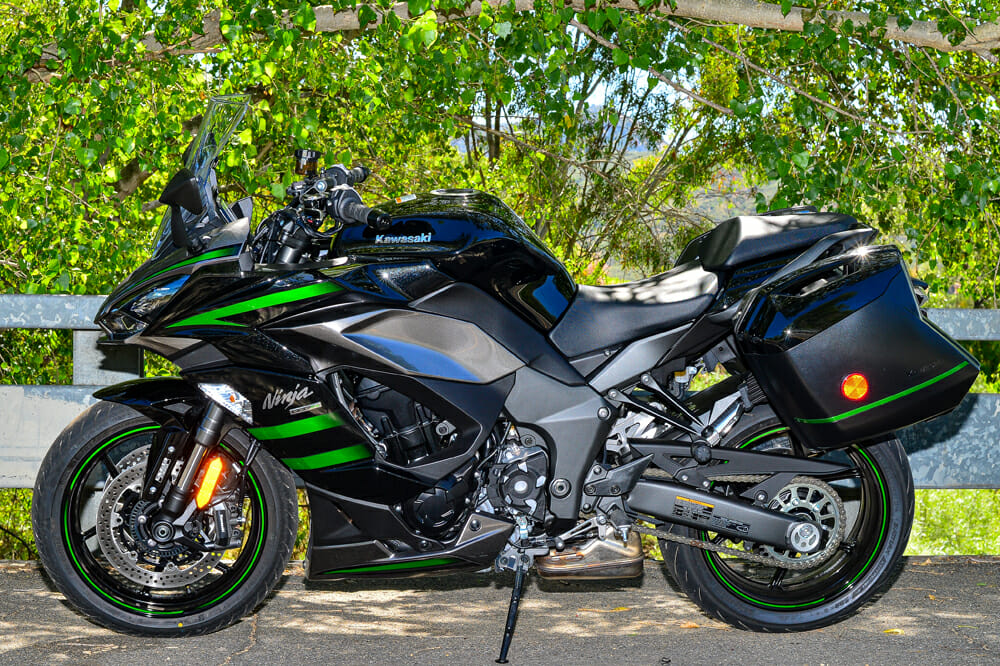 Pretty sweet-looking rig, hey? The high bars and nicely shaped tank make long rides a breeze.
Pretty sweet-looking rig, hey? The high bars and nicely shaped tank make long rides a breeze.
That number favors very much so against the competition—the BMW S 1000 XR is $17,645; Yamaha’s Tracer 900 GT is $12,999; the Ducati Multistrada 1260 S will knock you back a stern $21,295; KTM’s 1290 Super Duke GT a similar $20,599; and Honda’s VFR1200X will cost $15,999 (all prices MSRP, which isn’t necessarily what you’ll pay at the dealer). Only the Suzuki GSX-S1000F comes under the Kawasaki at $11,599.
And for 2020, you get a lot of new shiny things for your 12.3 Gs.
For a start, the bodywork has been completely revised. It’s a much sportier looking sport tourer from the big K, with a new 4.3-inch TFT dash that’s straight from the Versys 1000, flush-mounted indicators, a new and very comfortable seat (which also comes in a short and a tall version), a taller screen, an excellent range of view from the new mirrors, a taller and wider screen, and a new lighter, single-sided muffler to get rid of the bulky 2019 and previous editions.
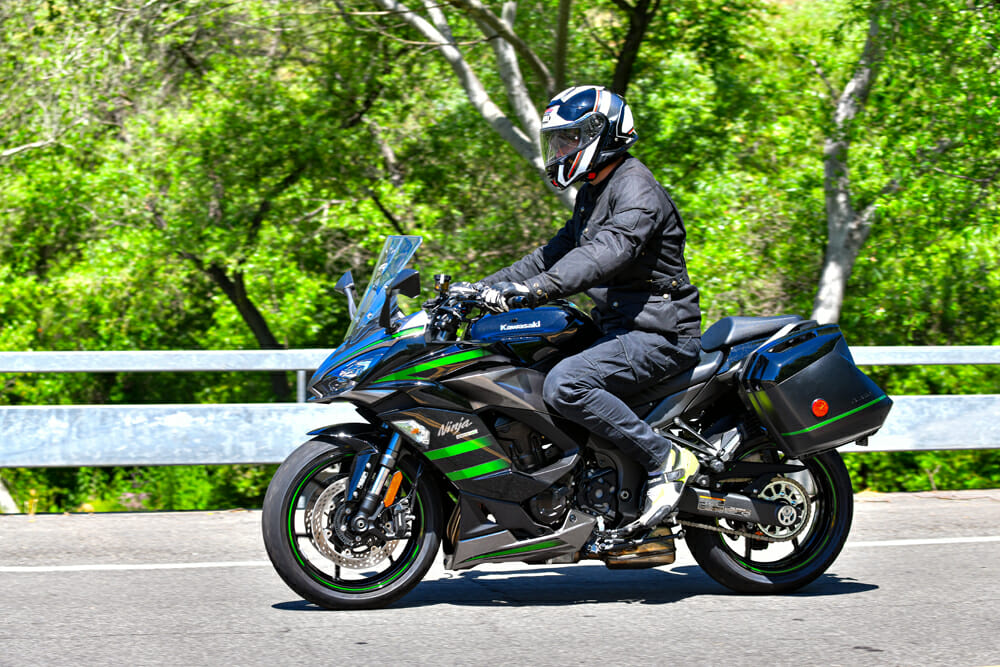 You can see here a little more leg room would be nice, but Kawasaki has a taller seat for that.
You can see here a little more leg room would be nice, but Kawasaki has a taller seat for that.
I mention these changes before the motor and chassis purely because the new Ninja has a much cleaner look to it, plus it’s vastly more comfortable than the old one. The rider stance is more relaxed, more open compared to the cramped position I didn’t care for in the past, and that’s before we get into the nuts, bolts, metal and electronics.
Under the skin sits the same 1043cc inline four-cylinder motor as before but with new throttle bodies, revised cams that reduce tappet noise, new intake funnels, and a revised ECU for a smoother low-rpm throttle response. Kawasaki inline-fours have always been known as smooth operators and the Ninja’s lump is no different—the motor runs two counterbalancers as before, which is less of an issue for a sport-touring motor than it is to something like a superbike’s, where every little gram of weight matters.
The Ninja produces delightfully smooth yet punchy acceleration. The new throttle mapping, combined with the lack of vibrations and the slick action of the standard fitment quickshifter, makes the Ninja a joy to ride. It’s plenty fast enough for most riders and definitely fast enough if you consider the target market of riders who want some ponies at their right hand, but not ZX-10RR levels of ponies.
The Ninja’s low-speed table manners are impeccable and, with relatively short gear ratios, you can zip around in sixth gear all day and not stress the motor, letting it lug you from one corner to the next. There’re four different riding modes on offer in Sport, Road, Rain or Rider, the last of which you can vary yourself for the throttle response (low or high) and three-level traction control setting. I put it in Rider Mode, set the power to High and the TC to level one and it was happy days on the Ninja.
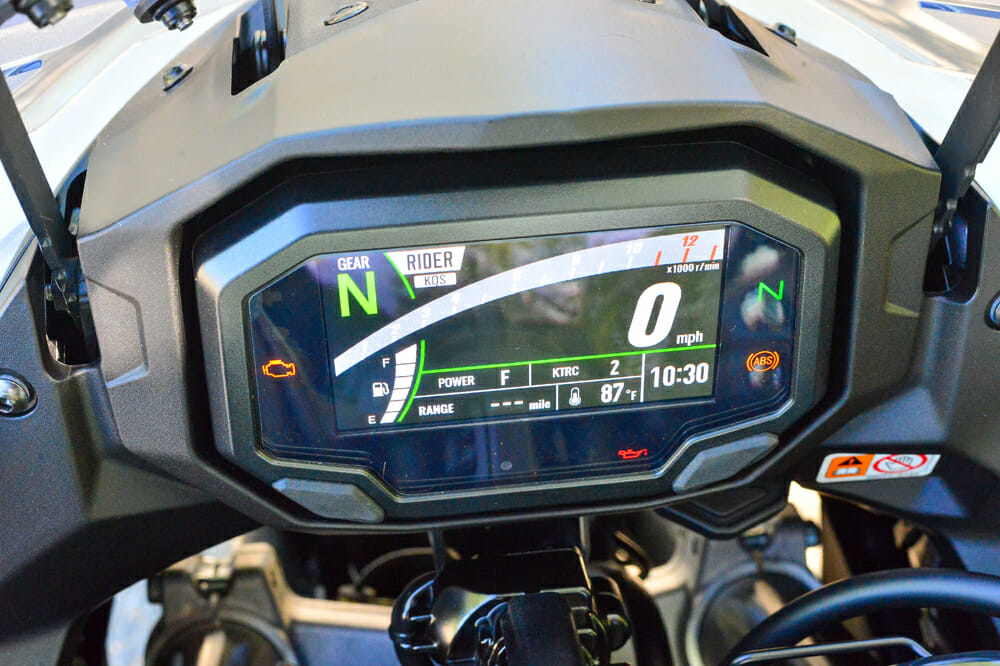 The new 4.3-inch dash is the same as what you’ll find on the Versys 1000. It’s not that pretty, but all the information is easily accessible and easy to read, plus you can pair your phone via the Rideology app.
The new 4.3-inch dash is the same as what you’ll find on the Versys 1000. It’s not that pretty, but all the information is easily accessible and easy to read, plus you can pair your phone via the Rideology app.
You get a six-axis Bosch Inertial Measurement Unit on the Ninja for cornering ABS and traction control mitigation, and thankfully, mercifully, Kawasaki has fitted cruise control as standard fitment on a bike costing 12 grand. See, Ducati, you can fit cruise control on a bike costing this much.
The chassis is for the most part the same as before, although the 41mm fork has come in for a slight revision to the low-speed circuit to give smoother action over sharp bumps. The overall ride is plush, certainly nothing like a full-faired sportbike, and even though it says sport touring on the packet, it’s more touring than sport, if you get my drift.
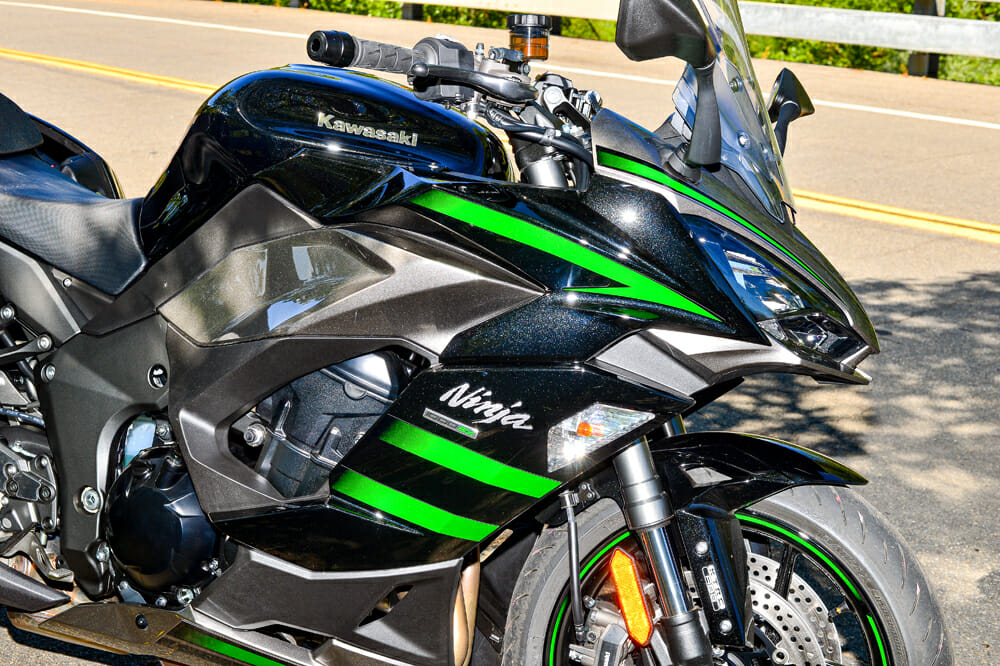 She sparkles in the sunlight with her metallic paint, baby!
She sparkles in the sunlight with her metallic paint, baby!
The rear suspension comes with the handy preload adjuster and is the same basic layout/unit as it always was, which isn’t a bad thing because the ride is lovely and smooth until you really wick it up. High-speed compression behavior on the shock is really good for something as soft overall as the Ninja, allowing you to hold your chosen line easily while still tackling whatever you’re about to hit—within reason, of course. You’re riding a bike that weighs a claimed 516 pounds, so it’s no featherweight and you can feel that weight as your speed increases.
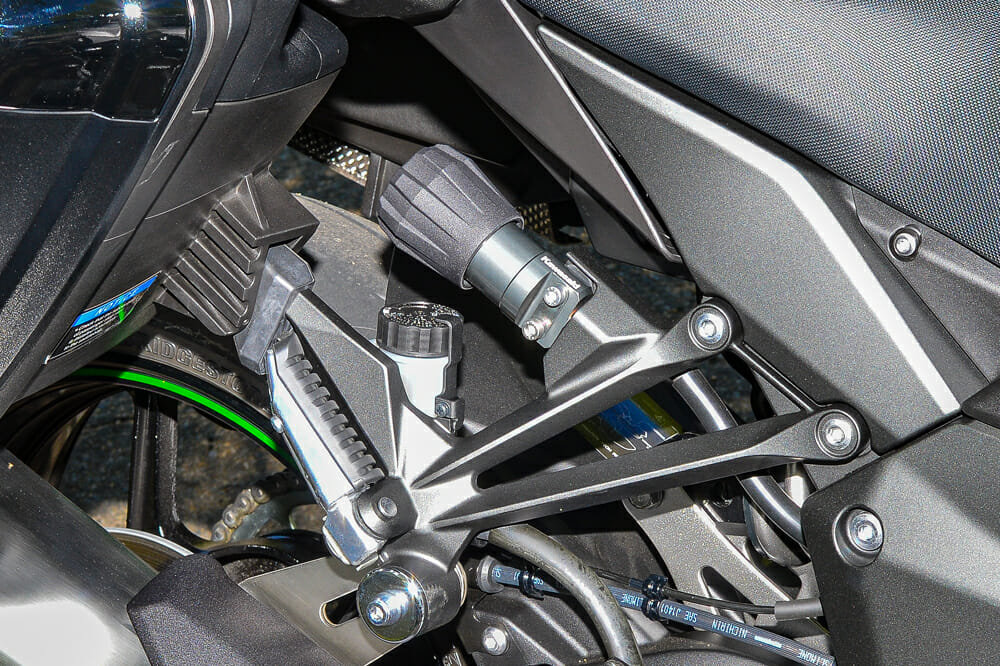 Remote preload adjustment is a must for easy changes with a passenger.
Remote preload adjustment is a must for easy changes with a passenger.
Be that as it may, if you treat the Ninja as a bike that can hustle through canyons at a respectable pace that maintains good chassis poise and feedback, you’ll be rewarded with an ultra-smooth ride on the way home, one that’s happy to have a passenger or a boot-full of luggage and still be fun to experience.
On that note, the 28-liter luggage on our test bike does not come as standard and will set you back $1129.95 from your local Kawasaki dealer. The Ninja comes with the rails and luggage points already fitted, however, the luggage largely failed the ever-important full-face helmet test. I tried an Arai Corsair-X, a Shoei X-Fourteen and a Scorpion EXO-R1 Corpus, all mediums, and all of which wouldn’t fit (although I did get a Shoei Neotec II to fit, just). If you’re a smaller head than me, you might be in luck, but you may have to invest in a helmet-lock cable, as well, with your Ninja.
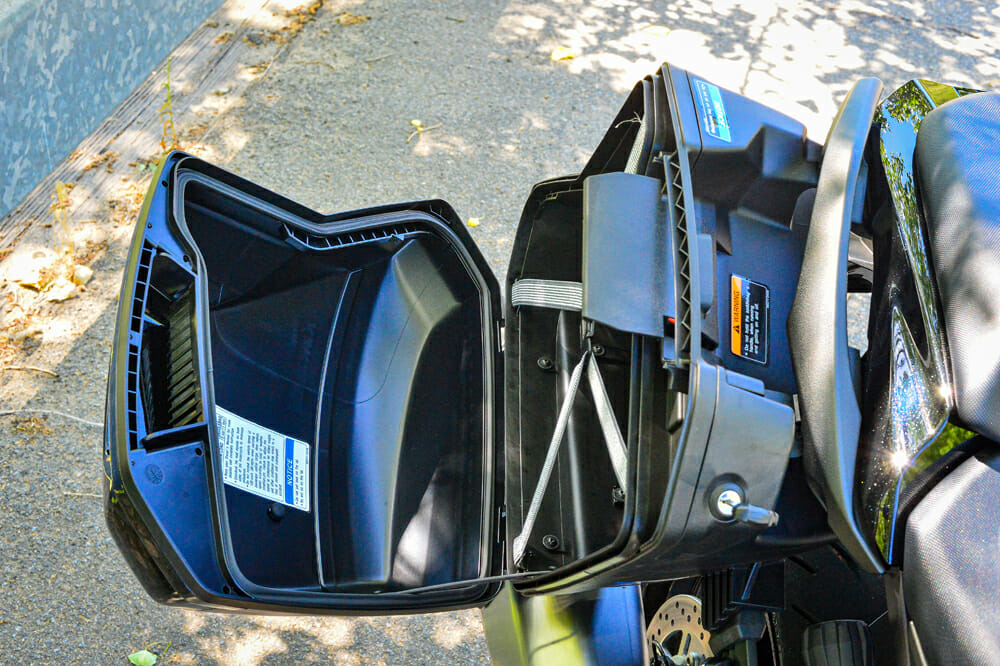 Plenty of space, unless you try to fit a full-face helmet, at which point you’ll have none. But for the extra bacon, the hard cases are absolutely worth it.
Plenty of space, unless you try to fit a full-face helmet, at which point you’ll have none. But for the extra bacon, the hard cases are absolutely worth it.
Braking performance of the KIBS (Kawasaki Intelligent Braking System), which is Kawasaki’s ABS algorithm, is enough for general cruising. If you reef on the lever aggressively, you get a pulse of ABS-ness at the lever but nowhere near as bad as what you’ll have on the Z900, for example. The KIBS combines with the KCMF (Kawasaki Cornering Management Function) and Bosch IMU which, in a nutshell, basically helps maintain chassis balance while turning and braking. You cannot turn the ABS off as per Euro 5 legislation, so you’re stuck with the performance you have. I didn’t have any real issue with how the system operated. A little extra feel at the lever might be nice but, all in all, I didn’t have half the braking problems I had on the Z900.
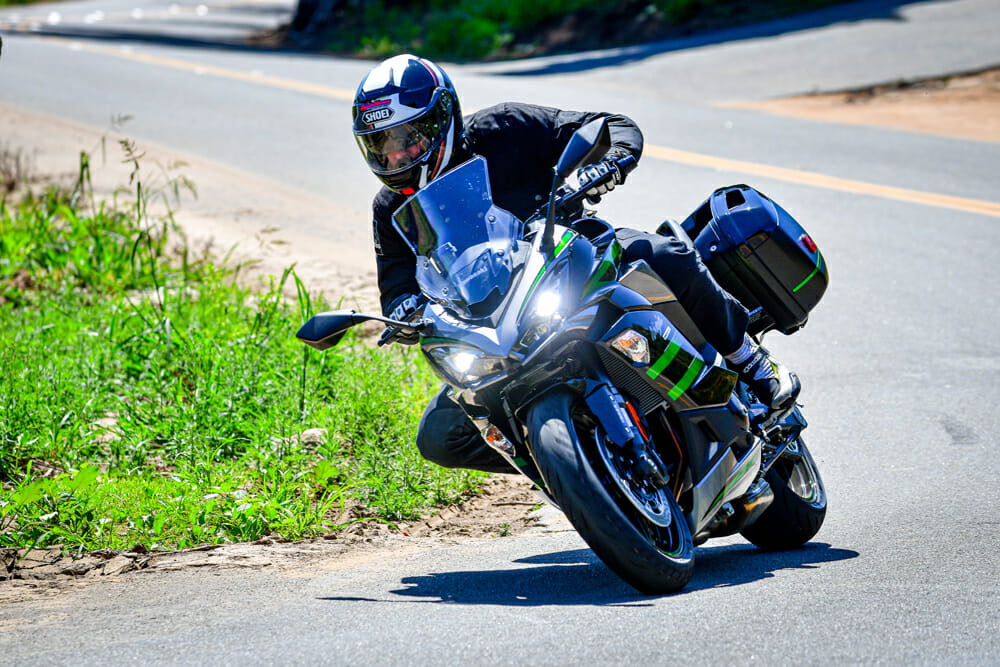 At 516 pounds with a tank of gas, the Ninja’s no featherweight, but it handles pretty much any road well.
At 516 pounds with a tank of gas, the Ninja’s no featherweight, but it handles pretty much any road well.
One of the nice features of the Ninja is a part often overlooked by OEMs when bringing out new or revised bikes—tires. The Ninja comes out with Bridgestone’s brilliant S22 as standard fitment (same standard tire as on the KTM 1290 Super Duke R), which is a tire capable of everything from long-haul rides to trackdays and everything in between. The Bridgestones offer excellent feel and grip through each point of the corner, although I have yet to put them through a long-distance test, so I can’t comment on that just now. We did a test on the S22s in Jerez last year, so if you’d like to see what goes into the S22, read our Bridgestone Hypersport Battlax S22 Product Launch.
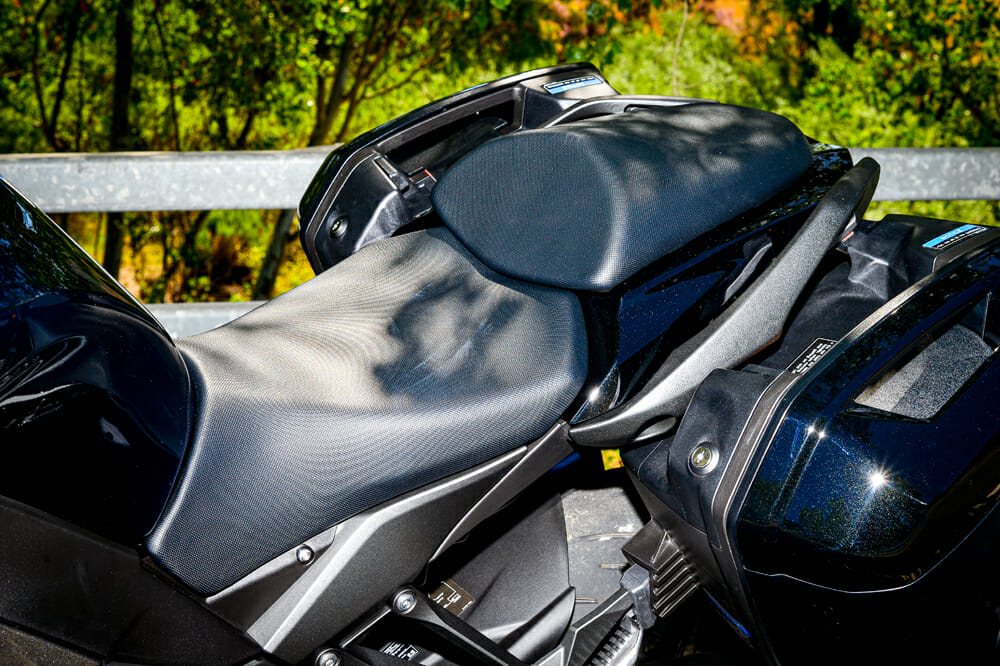 The seat is reworked for 2020 and very comfy for long rides, but tall riders will want the more leg room offered by the tall seat.
The seat is reworked for 2020 and very comfy for long rides, but tall riders will want the more leg room offered by the tall seat.
At the end of my tenure with the Ninja, I’ve got to put my hand up and admit I didn’t think I’d enjoy the bike as much as it did. There were a few things I didn’t enjoy—the standard seat height was a little low for my 6’1” frame, and the screen’s angle was aimed at the top of my head, so I’d get a bit of buffeting at high speed. But, to be honest, for the price of $12,399 and what you get—quickshifter, cruise control, TC, ABS, a great motor and a chassis that’ll handle most things you can throw at it on the road while still being a comfy ride—the Ninja 1000 ABS is absolutely a brilliant bike.
It’s nice to get surprises now and then. CN
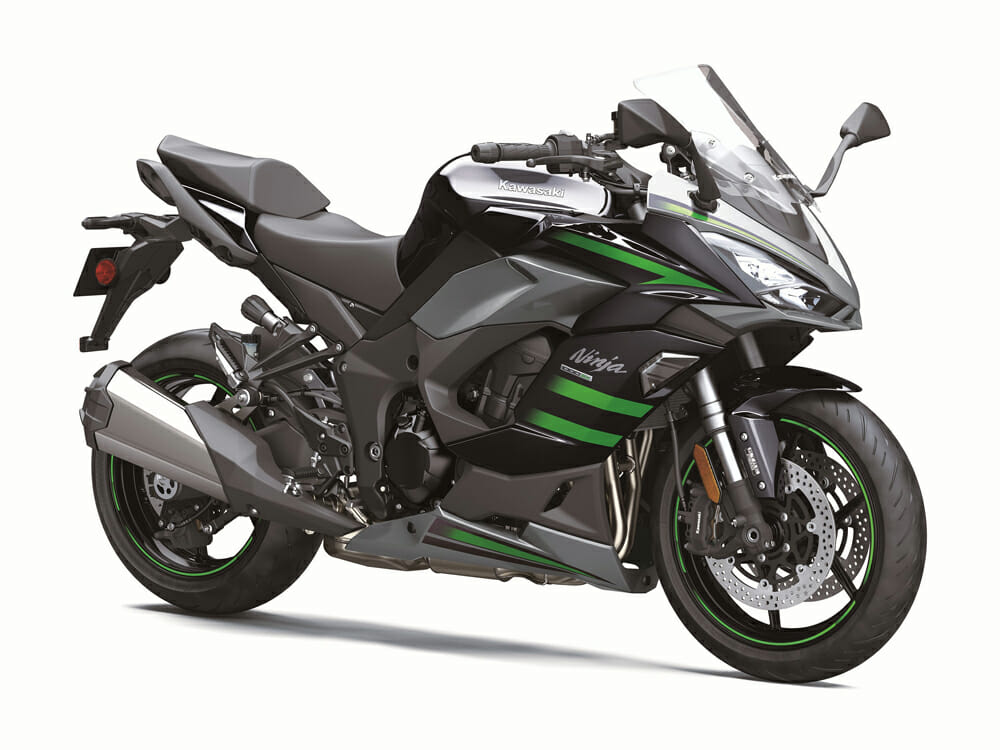
2020 Kawasaki Ninja 1000 ABS Specifications
|
|
| MSRP: |
$12,399/$13,529 as tested |
| Engine: |
Liquid-cooled, 4-stroke, 4-cylinder, DOHC, 16-valve |
| Fueling: |
EFI (4) 38mm Keihin throttle bodies and oval sub-throttles |
| Displacement: |
1043cc |
| Bore x stroke: |
77 x 56mm |
| Torque (claimed): |
81.7 lb-ft at 7300 rpm |
| Electronics: |
Kawasaki Traction Control (KTRC), Kawasaki Intelligent anti-lock Brake System (KIBS), twin power modes, Kawasaki Cornering Management Function (KCMF), quickshifter, cruise control, 4 riding modes |
| Transmission: |
6-speed |
| Clutch: |
Wet multi-disc |
| Chassis: |
Twin spar aluminum |
| Front suspension: |
41mm KYB inverted cartridge fork with step-less compression and rebound damping, adjustable spring preload |
| Rear suspension: |
Horizontal KYB monoshock with step-less rebound damping, remotely adjustable spring preload |
| Front-wheel travel: |
4.7 in. |
| Rear-wheel travel: |
5.4 in. |
| Front brake: |
Dual 300mm petal-style discs with radial-mounted, 4-piston monobloc calipers, ABS |
| Rear brake: |
Single 250mm petal-style disc with single-piston caliper, ABS |
| Front tire: |
Bridgestone S22 120/70 ZR17 in. |
| Rear tire: |
Bridgestone S22 190/50 ZR17 in. |
| Seat height: |
32.1 in. |
| Wheelbase: |
56.7 in. |
| Rake: |
24.5° |
| Trail: |
4.0 in. |
| Fuel capacity: |
5.1 gal. |
| Weight (curb, claimed): |
516 lbs. |
